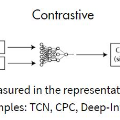Contrastive learning has shown remarkable results in recent self-supervised approaches for visual representation. By learning to contrast positive pairs' representation from the corresponding negatives pairs, one can train good visual representations without human annotations. This paper proposes Mix-up Contrast (MixCo), which extends the contrastive learning concept to semi-positives encoded from the mix-up of positive and negative images. MixCo aims to learn the relative similarity of representations, reflecting how much the mixed images have the original positives. We validate the efficacy of MixCo when applied to the recent self-supervised learning algorithms under the standard linear evaluation protocol on TinyImageNet, CIFAR10, and CIFAR100. In the experiments, MixCo consistently improves test accuracy. Remarkably, the improvement is more significant when the learning capacity (e.g., model size) is limited, suggesting that MixCo might be more useful in real-world scenarios.
翻译:对比性学习在最近自我监督的视觉表现方法中显示了显著的成果。 通过学习将正对对对应负对的正对比对对正对比对正对比,人们可以对好的视觉表现进行没有人文注解的训练。 本文提出Mix-up Contrast (MixCo), 将对比性学习概念扩大到从正对和负图像混合成的半正对半正对数。 MixCo 旨在了解演示的相对相似性, 反映混合图像的原始正数。 我们验证了MixCo在应用到TinyimageNet、 CIFAR10 和 CIFAR100 标准线性评估协议下的最新自我监督学习算法时的功效。 在实验中, MixCo 不断提高测试准确性。 值得注意的是, 当学习能力( 如模型大小) 有限时, 改进更为显著, 这表明MixCo 在现实世界情景中可能更有用 。




